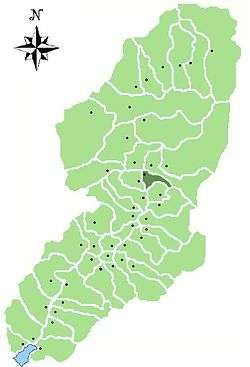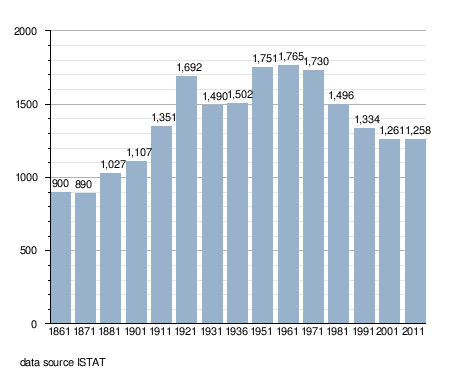Cedegolo
| Cedegolo Sedégol | ||
|---|---|---|
| Comune | ||
| Comune di Cedegolo | ||
 | ||
| ||
 | ||
 Cedegolo Location of Cedegolo in Italy | ||
| Coordinates: 46°04′39″N 10°21′2″E / 46.07750°N 10.35056°ECoordinates: 46°04′39″N 10°21′2″E / 46.07750°N 10.35056°E | ||
| Country | Italy | |
| Region | Lombardy | |
| Province / Metropolitan city | Brescia (BS) | |
| Frazioni | Grevo | |
| Government | ||
| • Mayor | Andrea Bortolo Pedrali | |
| Area | ||
| • Total | 11 km2 (4 sq mi) | |
| Population (2011)[1] | ||
| • Total | 1,258 | |
| • Density | 110/km2 (300/sq mi) | |
| Demonym(s) | Cedegolesi | |
| Time zone | CET (UTC+1) | |
| • Summer (DST) | CEST (UTC+2) | |
| Postal code | 25051 | |
| Dialing code | 0364 | |
| Patron saint | St. Jerome | |
| Saint day | September 30 | |
| Website | Official website | |
Cedegolo (Sedégol in camunian dialect) is an Italian comune of 1,258 inhabitants[1] in Val Camonica, province of Brescia, in Lombardy.
Geography
The village of Cedegolo located in a narrow gorge formed by Oglio river, on its eastern side. It is crossed by two streams: the Val Gravagna, further north, and the Poia, to the south.


History
The comune of Cedegolo was created in 1797, at the fall of the Republic of Venice, but became a hamlet of Grevo in 1798. The bridge over the river Poglia (Pôya in eastern Lombard), in the center of the village, was completed in 1592.
From Cedegolo in July 1866 the fourth regiment of volunteers in Italy and the Second Battalion of bersaglieri moved to enter Austrian Trentino, through the Lake Arno.
Monuments and places of interest)
Religious architectures
The churches of Cedegolo are:
- Parish of Saint Jerome, the first half of the XVII. The altar is by Pietro Ramus.
Society
Demographic trends

Traditions and folklore
The skötöm are in camunian dialect nicknames, sometimes personal, elsewhere showing the characteristic features of a community. The one which characterize the people of Cedegolo is Lìca-tóncc'.
Cedegolo is one of the few toponyms which in Eastern Lombard require the determinative article: el Sedegòl.
At least until the second half of the twentieth century the young men of Cedegolo followed the tradition of "tunà" (literally: to shoot) or "fa saltà le tòle" ("to make boxes jump") on the St. Jerome calendar day. It was a pretty dangerous activity involving controlled explosions of acetylene gas, prepared by mixing water with calcium carbide in a hole in the ground covered by a suitable container.
References
- 1 2 ISTAT Archived March 3, 2016, at the Wayback Machine.
External links
| Wikimedia Commons has media related to Cedegolo. |
- (Italian) Historical photos - Intercam
- (Italian) Historical photos - Lombardia Beni Culturali

